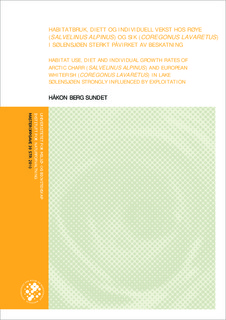| dc.description.abstract | Målsettingen for denne masteroppgaven har vært å finne ut hvordan den økte innsatsen i sikfisket i Sølensjøen de to siste tiårene har påvirket bestanden av røye (Salvelinus alpinus) og sik (Coregonus lavaretus). I juni, august og september 2009 ble det foretatt et forsøksfiske der det ble satt garnserier i strandsonen (littoralen), de åpne vannmasser (pelagialen) og på dypt vann (profundalen) i Sølensjøen. Ut fra resultatene fra dette forsøksfisket er dietten, konkurranseforholdet og bestandsstatusen til røye og sik analysert.
Siken bruker alle habitatene i Sølensjøen, men i motsetning til tidligere undersøkelser, ser det ut til at det er langt lavere tetthet av sik i littoralen der abbor (Perca fluviatilis) og harr (Thymallus thymallus) nå er helt dominerende. Årsaken til dette skyldes antakelig økt fangstinnsats med pelagiske garn i fisket etter sik, og dermed er det trolig blitt lavere beskatning av abbor og harr i littoralen. Dette har antakelig gitt disse to artene et konkurransefortrinn ovenfor sik. Selv om røya forkommer i større mengder nå enn den gjorde tidlig på 1990-tallet, har det blitt tatt lite røye under det tradisjonelle fisket de to siste årene. Dette er en indikasjon på at røya på ny er inne i en negativ bestandsutvikling. Veksten til røya er lite utholdende, med stagnering etter den femte vekstsesongen, og få individer når lengder på over 29 cm. Siken har vist en positiv respons på den økte beskatning. Den vokser fortere, veksten er mer utholdende og den kjønnsmodnes ved yngre alder nå enn den gjorde på 1980- og 1990-tallet. I løpet av de 24 siste årene har det aldri blitt dokumentert bedre kondisjon på siken i Sølensjøen. Siken utnytter imidlertid en stor andel av de mindre zooplanktonformene, som Bosmina sp., noe som indikerer at beitetrykket er relativt hardt i innsjøen.
Forholdet mellom røye og sik i Sølensjøen følger fortsatt det klassiske mønsteret for røye- og siksjøer; røya er fortrengt til de dypere delene av pelagialen og vokser dårlig, mens siken dominerer i de øvre deler av pelagialen. Imidlertid indikerer den positive trenden i sikens vekst, sammenholdt med røyas tilbakekomst i fangstene, at den økte beskatningen av sik hjelper. Når røya nå igjen er på vikende front, viser det at innsatsen i sikfisket kanskje bør økes ytterligere. The aim of this master thesis is to document if there has been any change in the populations of
Arctic charr (Salvelinus alpinus) and whitefish (Coregonus lavaretus) due to the increased
effort in the whitefish fishery in Lake Sølensjøen during the last two decades. In June, August
and September 2009, a gillnet fishery was conducted. The diet, competitive conditions and the
stock status of both Arctic charr and whitefish were examined.
The whitefish is found in all habitats in the lake. However, recently there has been a shift in
the dominance in the littoral zone: as opposed to earlier findings the whitefish is now
dominated by grayling (Thymallus thymallus) and perch (Perca fluviatilis). The fishing effort
in the lake is directed towards whitefish in the open water and Arctic charr on its spawning
grounds. The low fishing mortality the grayling and perch face, have probably given them a
competitive advantage towards whitefish. Even though the Arctic charr occur more frequently
in catches now than in the 1990’s, the output of the traditional Arctic charr-fishery has been
scarce during the last two years. Not only does this suggest that the Arctic charr population
again is decreasing, but the growth of individual Arctic charr is poorer and shows lower
endurance now than in the 1980’s. The growth stagnates during the fifth growing season, and
few individuals reach lengths above 29 cm. The whitefish on the other hand, shows a more
positive response to the increased mortality. The individual whitefish grows faster, the growth
is more persistent and it reaches sexual maturity at an earlier age than the whitefish in the
1980’s and 1990’s did. During the last 24 years of surveys in the lake the whitefish condition
has never been better than observed in 2009. Nevertheless the whitefish now exploit the small
zooplankton, like Bosmina sp., to a larger degree and this indicates that the predation pressure
on the zooplankton is high.
The outcome of the competition between Arctic charr and whitefish in lake Sølensjøen is the
classic one; the Arctic charr is expelled to the deeper parts of the pelagic, and display poor
individual growth. However the whitefish has responded well to the increased fishing
pressure. This, and the return of the Arctic charr in the catches, shows that it is possible to
turn negative trends in Arctic charr and whitefish populations. The recent decline in Arctic
charr capture indicates that the whitefish exploitation probably has to be increased in order to
re-establish the Arctic charr-fishery. | en_US |
